简介
使用SpringBoot;
1)、创建SpringBoot应用,选中我们需要的模块; 比如web等等
2)、SpringBoot已经默认将这些场景配置好了,只需要在配置文件中指定少量配置就可以运行起来
3)、自己编写业务代码;
参考这里:
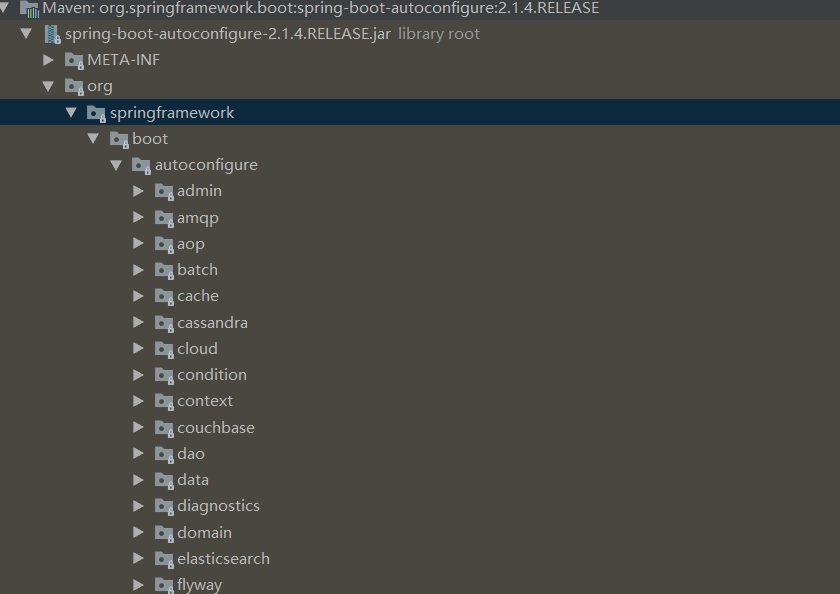
比如要连接数据库的:有数据库的配置
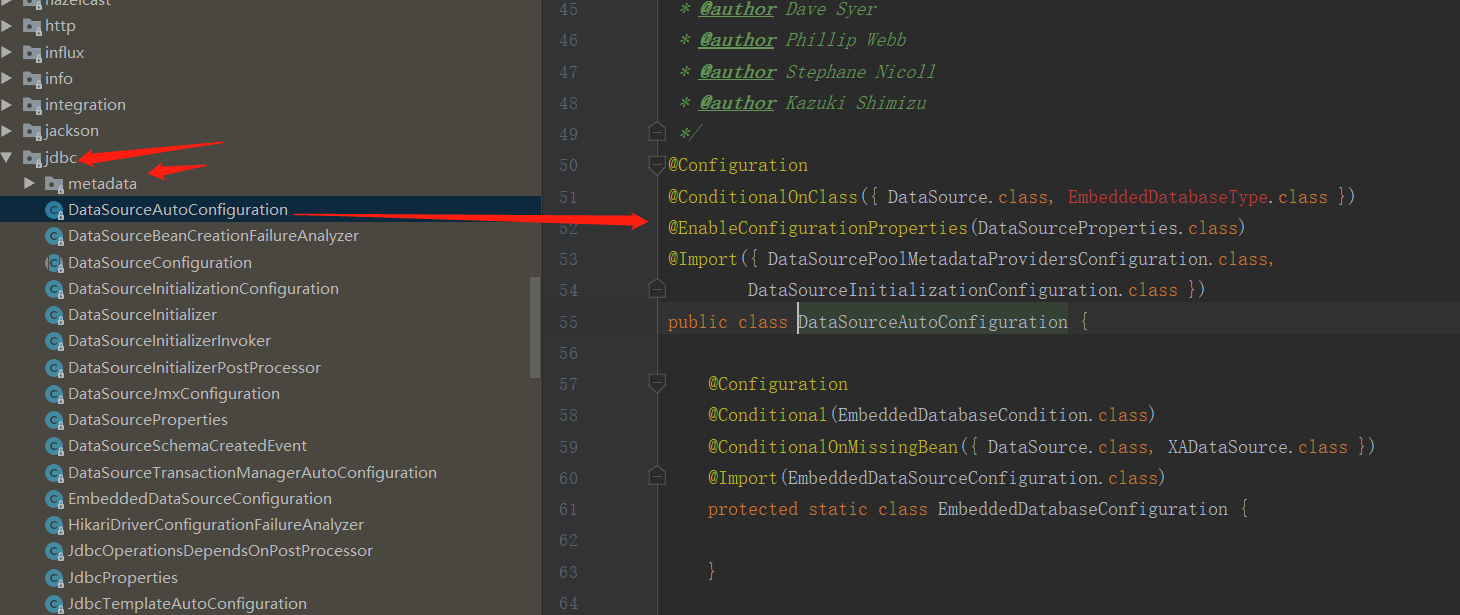
查看 @EnableConfigurationProperties中的 dataSourceProperties.class
@ConfigurationProperties(prefix = "spring.datasource") //跟配置绑定 public class DataSourceProperties implements BeanClassLoaderAware, InitializingBean {
自动配置原理?
这个场景SpringBoot帮我们配置了什么?能不能修改?能修改哪些配置?能不能扩展?xxx
xxxxAutoConfiguration:帮我们给容器中自动配置组件;
xxxxProperties:配置类来封装配置文件的内容;
Web:
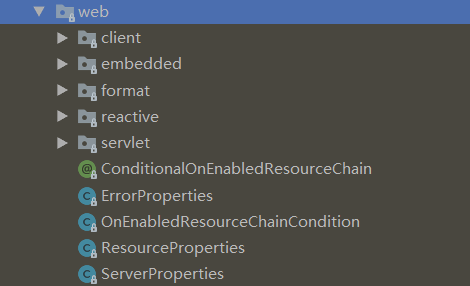
关于web 就是 restful的栗子了
restful web开发
Spring boot 最后打成个jar包,web开发时候,页面放哪里?
Spring boot对静态资源的映射规则
这个场景SpringBoot帮我们配置了什么?能不能修改?能修改哪些配置?能不能扩展?xxx
xxxxAutoConfiguration:帮我们给容器中自动配置组件;
xxxxProperties:配置类来封装配置文件的内容;
idea: ctrl+shift+n

这个类里面有个方法: 添加资源映射
public void addResourceHandlers(ResourceHandlerRegistry registry) { if (!this.resourceProperties.isAddMappings()) { logger.debug("Default resource handling disabled"); } else { Duration cachePeriod = this.resourceProperties.getCache().getPeriod(); CacheControl cacheControl = this.resourceProperties.getCache().getCachecontrol().toHttpCacheControl(); if (!registry.hasMappingForPattern("/webjars/**")) { //所有 /webjars/** this.customizeResourceHandlerRegistration(registry.addResourceHandler(new String[]{"/webjars/**"}).addResourceLocations(new String[]{"classpath:/META-INF/resources/webjars/"}).setCachePeriod(this.getSeconds(cachePeriod)).setCacheControl(cacheControl)); } String staticPathPattern = this.mvcProperties.getStaticPathPattern(); if (!registry.hasMappingForPattern(staticPathPattern)) { this.customizeResourceHandlerRegistration(registry.addResourceHandler(new String[]{staticPathPattern}).addResourceLocations(getResourceLocations(this.resourceProperties.getStaticLocations())).setCachePeriod(this.getSeconds(cachePeriod)).setCacheControl(cacheControl)); } } }
所有 /webjars/** 都去 classpath:/META-INF/resources/webjars/ 这里找资源
webjars: 以jar包方式引入静态资源
参考:https://www.webjars.org/
<!‐‐引入jquery‐webjar‐‐>在访问的时候只需要写webjars下面资源的名称即可 <dependency> <groupId>org.webjars</groupId> <artifactId>jquery</artifactId> <version>3.3.1</version> </dependency>
引入后:
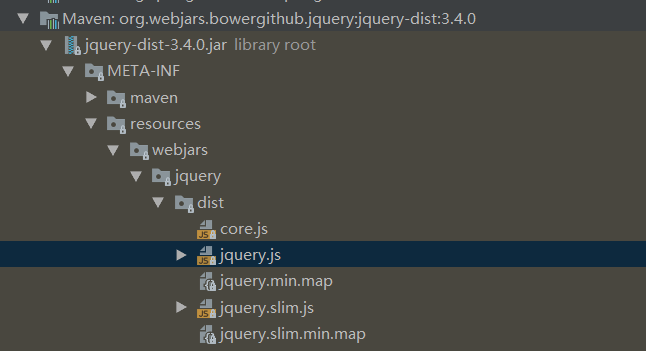
根据图生成地址
访问地址:http://localhost:8080/webjars/jquery/dist/jquery.js
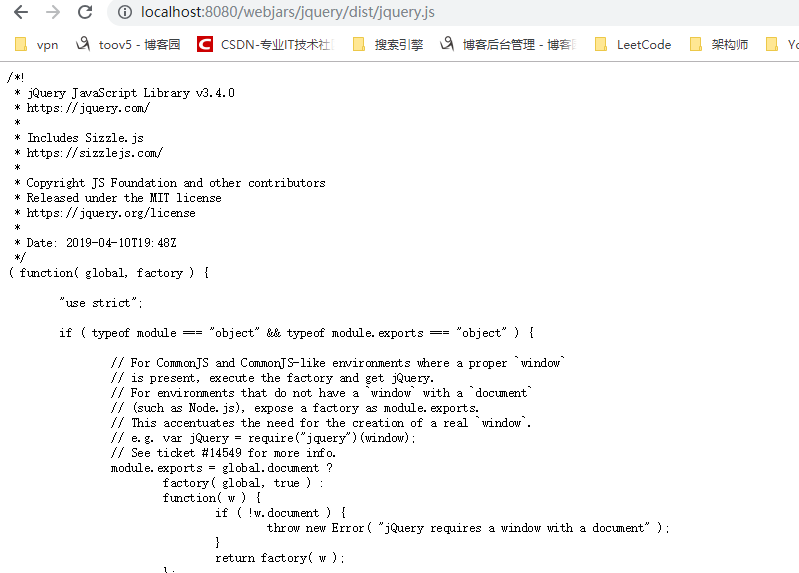
在访问时候 只需要写webjars下面的资源名称即可
资源映射:
@ConfigurationProperties( prefix = "spring.resources", ignoreUnknownFields = false ) public class ResourceProperties { private static final String[] CLASSPATH_RESOURCE_LOCATIONS = new String[]{"classpath:/META-INF/resources/", "classpath:/resources/", "classpath:/static/", "classpath:/public/"};
可以设置和静态资源有关的参数, 缓存时间等
2)"/**" 访问当前项目的任何资源,都去(静态资源的文件夹)找映射
classpath 等价于 Java包同级的目录
"classpath:/META‐INF/resources/",
"classpath:/resources/",
"classpath:/static/",
"classpath:/public/"
"/":当前项目的根路径
classpath:
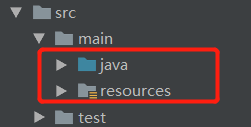
比如:localhost:8080/abc === 去静态资源文件夹里面找abc
3)、欢迎页; 静态资源文件夹下的所有index.html页面;被"/**"映射;
localhost:8080/ 找index页面
4)、所有的 **/favicon.ico 都是在静态资源文件下找;
其实都是可以配置的啊哈:
@ConfigurationProperties( prefix = "spring.resources", ignoreUnknownFields = false ) public class ResourceProperties { private static final String[] CLASSPATH_RESOURCE_LOCATIONS = new String[]{"classpath:/META-INF/resources/", "classpath:/resources/", "classpath:/static/", "classpath:/public/"}; private String[] staticLocations; private boolean addMappings; private final ResourceProperties.Chain chain; private final ResourceProperties.Cache cache;
可以修改静态文件夹位置!
Spring boot 不支持jsp ,Spring boot推荐使用模板引擎。
Velocty FreeaKer
模板:
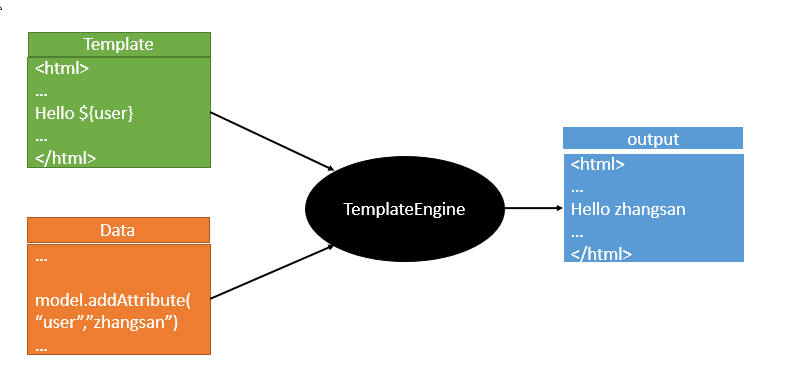
把数据和模板 交给模板引擎
Spring boot 推荐使用 Thymeleaf
引入thymeleaf ,开发
引入相应的starter
<dependency> <groupId>org.springframework.boot</groupId> <artifactId>spring‐boot‐starter‐thymeleaf</artifactId> 2.1.6 </dependency> 切换thymeleaf版本 <properties> <thymeleaf.version>3.0.9.RELEASE</thymeleaf.version> <!‐‐ 布局功能的支持程序 thymeleaf3主程序 layout2以上版本 ‐‐> <!‐‐ thymeleaf2 layout1‐‐> <thymeleaf‐layout‐dialect.version>2.2.2</thymeleaf‐layout‐dialect.version> </properties>
Thymeleaf使用
@ConfigurationProperties(prefix = "spring.thymeleaf") public class ThymeleafProperties { private static final Charset DEFAULT_ENCODING = Charset.forName("UTF‐8"); private static final MimeType DEFAULT_CONTENT_TYPE = MimeType.valueOf("text/html"); public static final String DEFAULT_PREFIX = "classpath:/templates/"; public static final String DEFAULT_SUFFIX = ".html"; //
只要我们把HTML页面放在classpath:/templates/,thymeleaf就能自动渲染;
使用:
1、导入thymeleaf的名称空间
<html lang="en" xmlns:th="http://www.thymeleaf.org">
2、使用thymeleaf语法;
<!DOCTYPE html> <html lang="en" xmlns:th="http://www.thymeleaf.org"> <head> <meta charset="UTF‐8"> <title>Title</title> </head> <body> <h1>成功!</h1> <!‐‐th:text 将div里面的文本内容设置为 ‐‐> <div th:text="${hello}">这是显示欢迎信息</div> </body> </html>
语法规则 自行学习吧 不详细介绍了
Spring Boot 与 Spring mvc 自动配置原理:
参考:https://docs.spring.io/spring-boot/docs/1.5.10.RELEASE/reference/htmlsingle/#boot-features-developing-web-applications
1. Spring MVC auto-configuration
Spring Boot 自动配置好了SpringMVC
以下是SpringBoot对SpringMVC的默认配置:(WebMvcAutoConfiguration):
Inclusion of ContentNegotiatingViewResolver and BeanNameViewResolver beans,自动配置了ViewResolver(视图解析器:根据方法的返回值得到视图对象(View),视图对象决定如何渲染(转发?重定向?))
到这个类里面去:
@Configuration @ConditionalOnWebApplication(type = Type.SERVLET) @ConditionalOnClass({ Servlet.class, DispatcherServlet.class, WebMvcConfigurer.class }) @ConditionalOnMissingBean(WebMvcConfigurationSupport.class) @AutoConfigureOrder(Ordered.HIGHEST_PRECEDENCE + 10) @AutoConfigureAfter({ DispatcherServletAutoConfiguration.class, TaskExecutionAutoConfiguration.class, ValidationAutoConfiguration.class }) public class WebMvcAutoConfiguration { public static final String DEFAULT_PREFIX = ""; public static final String DEFAULT_SUFFIX = ""; private static final String[] SERVLET_LOCATIONS = { "/" }; @Bean @ConditionalOnMissingBean(HiddenHttpMethodFilter.class) @ConditionalOnProperty(prefix = "spring.mvc.hiddenmethod.filter", name = "enabled", matchIfMissing = true) public OrderedHiddenHttpMethodFilter hiddenHttpMethodFilter() { return new OrderedHiddenHttpMethodFilter(); } @Bean @ConditionalOnMissingBean(FormContentFilter.class) @ConditionalOnProperty(prefix = "spring.mvc.formcontent.filter", name = "enabled", matchIfMissing = true) public OrderedFormContentFilter formContentFilter() { return new OrderedFormContentFilter(); }
这个类里面有这个配置:视图解析器 (我们可以给容器中添加视图解析器)
@Bean @ConditionalOnBean(ViewResolver.class) @ConditionalOnMissingBean(name = "viewResolver", value = ContentNegotiatingViewResolver.class) public ContentNegotiatingViewResolver viewResolver(BeanFactory beanFactory) { ContentNegotiatingViewResolver resolver = new ContentNegotiatingViewResolver(); resolver.setContentNegotiationManager( beanFactory.getBean(ContentNegotiationManager.class)); // ContentNegotiatingViewResolver uses all the other view resolvers to locate // a view so it should have a high precedence resolver.setOrder(Ordered.HIGHEST_PRECEDENCE); return resolver; }
小结:
ContentNegotiatingViewResolver:组合所有的视图解析器的;
如何定制:我们可以自己给容器中添加一个视图解析器;自动的将其组合进来;
(验证方法 在doDispatch方法 打断点 进来的是自己定义的视图解析器组件)
Support for serving static resources, including support for WebJars (see below).静态资源文件夹路
径,webjars
Static index.html support. 静态首页访问
Custom Favicon support (see below). favicon.ico
自动注册了 of Converter , GenericConverter , Formatter beans.
Converter:转换器; public String hello(User user):类型转换使用Converter
Formatter 格式化器; 2017.12.17===Date;
关于Spring mvc的扩展问题,大家可以了解下。
<mvc:view‐controller path="/hello" view‐name="success"/> <mvc:interceptors> <mvc:interceptor> <mvc:mapping path="/hello"/> <bean></bean> </mvc:interceptor> </mvc:interceptors>
编写一个配置类(@Configuration),是WebMvcConfigurerAdapter类型;不能标注@EnableWebMvc;
既保留了所有的自动配置,也能用我们扩展的配置;
//使用WebMvcConfigurerAdapter可以来扩展SpringMVC的功能 @Configuration public class MyMvcConfig extends WebMvcConfigurerAdapter { @Override public void addViewControllers(ViewControllerRegistry registry) { // super.addViewControllers(registry); //浏览器发送 /atguigu 请求来到 success registry.addViewController("/atguigu").setViewName("success"); } }
原理:
1)、WebMvcAutoConfiguration是SpringMVC的自动配置类
2)、在做其他自动配置时会导入;@Import(EnableWebMvcConfiguration.class)
@Configuration public static class EnableWebMvcConfiguration extends DelegatingWebMvcConfiguration { private final WebMvcConfigurerComposite configurers = new WebMvcConfigurerComposite(); //从容器中获取所有的WebMvcConfigurer @Autowired(required = false) public void setConfigurers(List<WebMvcConfigurer> configurers) { if (!CollectionUtils.isEmpty(configurers)) { this.configurers.addWebMvcConfigurers(configurers); //一个参考实现;将所有的WebMvcConfigurer相关配置都来一起调用; @Override // public void addViewControllers(ViewControllerRegistry registry) { // for (WebMvcConfigurer delegate : this.delegates) { // delegate.addViewControllers(registry); // } } } }
3)、容器中所有的WebMvcConfigurer都会一起起作用;
4)、我们的配置类也会被调用;
效果:SpringMVC的自动配置和我们的扩展配置都会起作用;
3、全面接管SpringMVC;
SpringBoot对SpringMVC的自动配置不需要了,所有都是我们自己配置;所有的SpringMVC的自动配置都失效了
我们需要在配置类中添加@EnableWebMvc即可;
//使用WebMvcConfigurerAdapter可以来扩展SpringMVC的功能 @EnableWebMvc @Configuration public class MyMvcConfig extends WebMvcConfigurerAdapter { @Override public void addViewControllers(ViewControllerRegistry registry) { // super.addViewControllers(registry); //浏览器发送 /atguigu 请求来到 success registry.addViewController("/atguigu").setViewName("success"); } }
原理:
为什么@EnableWebMvc自动配置就失效了;
@EnableWebMvc的核心
@Import(DelegatingWebMvcConfiguration.class) public @interface EnableWebMvc {
@Configuration public class DelegatingWebMvcConfiguration extends WebMvcConfigurationSupport {
@Configuration @ConditionalOnWebApplication @ConditionalOnClass({ Servlet.class, DispatcherServlet.class, WebMvcConfigurerAdapter.class }) //容器中没有这个组件的时候,这个自动配置类才生效 @ConditionalOnMissingBean(WebMvcConfigurationSupport.class) @AutoConfigureOrder(Ordered.HIGHEST_PRECEDENCE + 10) @AutoConfigureAfter({ DispatcherServletAutoConfiguration.class, ValidationAutoConfiguration.class }) public class WebMvcAutoConfiguration {
4)@EnableWebMvc将WebMvcConfigurationSupport组件导入进来;
5)、导入的WebMvcConfigurationSupport只是SpringMVC最基本的功能;
总结:
如何修改SpringBoot的默认配置
模式:
1)、SpringBoot在自动配置很多组件的时候,先看容器中有没有用户自己配置的(@Bean、@Component)如
果有就用用户配置的,如果没有,才自动配置;如果有些组件可以有多个(ViewResolver)将用户配置的和自己默
认的组合起来;
2)、在SpringBoot中会有非常多的xxxConfigurer帮助我们进行扩展配置
3)、在SpringBoot中会有很多的xxxCustomizer帮助我们进行定制配置